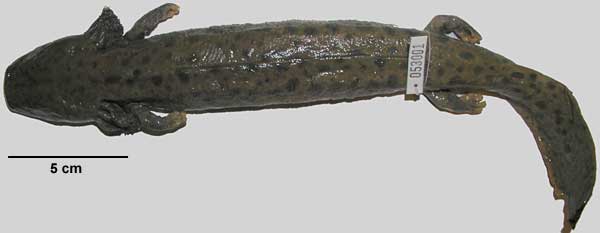 Expert annotations for this species! See below. Expert annotations for this species! See below.
Necturus is a perennibranchiate (retaining external gills) salamander of the Euramerican clade Proteidae. The genus is confined to North America (Eastern USA and Canada) and is represented by six species, of which the most familiar is the common mudpuppy (N. maculosus). Necturus is fully aquatic, living in rivers and streams and feeding mainly on small fish, aquatic invertebrates (e.g., snails, crayfish), and occasionally aquatic plants. It has small functional eyes, unlike its sister taxon, Proteus. The genus has a fossil history in North America extending back to the Palaeocene (Naylor, 1978; Estes, 1981). |
|
Skull shape varies in perennibranchiate salamanders. Some taxa have broad heads (e.g., cryptobranchids), others have narrow heads. Necturus belongs to the latter type. The skull is rather elongate with the loss of several dermal bones (maxillae, septomaxillae, lacrimal). The premaxillae are paired with long posterior processes that fully separate the nasals, each of which arises from a single lateral anlage. The pterygoids are retained and bear teeth, leading to the suggestion that they represent a fusion of the pterygoid and a vestigial palatine. The compound bone is called the palatopterygoid (Trueb, 1993). The parasphenoid wings are pierced by foramina for the internal carotid arteries passing through into the cranial cavity. In the ear region, the stapes is present and free, but the operculum has been lost. There is also no free sphenethmoid (orbitosphenoid) bone. De Beer (1937) reports that the orbital cartilages fuse with the trabeculae and thus become incorporated into the descending flange of the parietal. In the lower jaw, a distinct coronoid bone is present and this bears teeth (Trueb, 1993).
The marginal teeth of Necturus remain pedicellate (with a distinct crown and basal pedicel), unlike those of some perennibranchiate salamanders where pedicelly is lost.
Additional Information on the Skull
Click on the thumbnails below for a detailed description of the skull in standard anatomical views.
Click on the thumbnail below for a description of internal features of the skull based on selected coronal slices.

About the Species
This specimen (TNHC 53001) was scanned for Dr. Timothy Rowe of the Department of Geological Sciences, The University of Texas at Austin. Funding for scanning and image processing was provided by a National Science Foundation Digital Libraries Initiative grant to Dr. Rowe.

Dorsal view of the scanned specimen.

About this Specimen
The specimen was scanned by Matthew Colbert on 10 July 2003 along the coronal axis for a total of 1134 1024x1024 pixel slices. Each slice is 0.073 mm thick, with an interslice spacing of 0.073 mm and a field of reconstruction of 59 mm.

About the
Scan
Literature
Brandon, R. A. 1969. Taxonomic relationships of the salamander genera Proteus and Necturus. National Speleological Society Bulletin 31:33-36.
De Beer, G. R. 1937. The Development of the Vertebrate Skull. Chicago: Chicago University Press.
Estes, R. 1981. Gymnophiona, Caudata. In: Wellnhofer, P. (ed.), Encyclopedia of Herpetology, Volume 2. Gustav Fischer Verlag, Stuttgart and New York.
Hecht, M. 1957. A case of parallel evolution in salamanders. Proceedings of the Zoological Society, Calcutta, Mookerjee Memorial Volume 1957:283-292.
Hecht, M., and J. L. Edwards. 1976. The determination of parallel or monophyletic relationships: the proteid salamanders – a test case. The American Naturalist 110:653-677.
Lapage, E. O. 1928. The septomaxillary in the Amphibia Urodela. Journal of Morphology and Physiology 45:441-471.
Naylor, B. G. 1978. The earliest known Necturus (Amphibia, Urodela) from the Palaeocene Ravenscrag Formation of Saskatchewan. Journal of Herpetology 12:565-569.
Trueb, L. 1993. Patterns of cranial diversity among Lissamphibia, pp.255-343. In Hanken, J. and Hall, B. K. (eds), The Skull, Volume 2, Patterns of Structural and Systematic Diversity. Chicago: The University of Chicago Press.
Walker, W. W. 1970. Vertebrate Dissection. W. B. Saunders Company, Philadelphia.
Wiedersheim, R. 1977. Das Kopfskelet der Urodelen. Morphologiche Jahrbuch 3:352-548. (Note that this author refers to Necturus as Menobatrachus, but provides one of the most detailed descriptions, with illustrations and cross sections, that exist for this genus).
Links
Necturus maculosus on the Animal Diversity Web (University of Michigan Museum of Zoology)
Necturus maculosus page by students at Earlham College, Richmond, Indiana
mudpuppy dissection with labeled images of soft anatomy by students at the University of Minnesota, Duluth

Literature
& Links
None available.

Additional
Imagery
|

